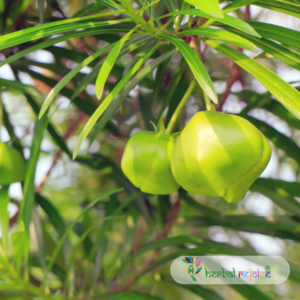Introduction
The Yellow Oleander plant, scientifically known as Thevetia peruviana (Pers.) K. Schum., belongs to the Apocynaceae family. This plant is native to tropical America and is widely cultivated as a hedge plant in the plains of India. It is also referred to as Pita-Karavira and Ashvaghna in Ayurvedic medicine, and Pachiyalari in Siddha/Tamil medicine.
Therauptic Properties
The bark and leaves of the Yellow Oleander plant have long been recognized for their therapeutic properties. They possess bitter cathartic and emetic qualities, but it’s important to note that all parts of the plant produce a poisonous latex. The roots are commonly used as a plaster for treating tumors.
Chemical Constituents
One of the distinctive features of the Yellow Oleander plant is its high concentration of glycosides. The kernels of the plant contain nearly seven times more glycosides than the leaves, stems, flowers, or fruit pulp. The roots and bark of the plant also contain glycosides. Among these glycosides, peruvoside is the most important cardiac glycoside. It has been found to cause a decrease in right arterial pressure and an increase in cardiac output. In some cases, peruvoside has shown promising results in treating arrhythmia.

Other glycosides found in the Yellow Oleander plant, such as thevetin, have been reported to exhibit digitalis-like effects on the heart. Neriifolin, another cardiac glycoside found in the plant, has a moderate potency as a cardiac glycoside. On the other hand, cerberin is weaker than neriifolin, and cerebroside is the weakest in terms of its cardiac effects. Aside from the seeds, neriifolin and peruvoside have also been isolated from the bark of the plant in small amounts.
Dosage
When consumed for its therapeutic benefits, the recommended dosage of Yellow Oleander root is 50-125 mg of powder. However, it is important to exercise caution when using any part of the plant due to its highly poisonous nature.
Conclusion
In conclusion, the Yellow Oleander plant, scientifically known as Thevetia peruviana, is a valuable source of cardiac glycosides. Its bark and leaves possess cathartic and emetic properties, while its roots have been used to treat tumors. Although all parts of the plant produce a poisonous latex, the Yellow Oleander’s glycosides, such as peruvoside and neriifolin, have shown promising effects on cardiac health. Care should be taken when using this plant for therapeutic purposes, and the recommended dosage of Yellow Oleander root is 50-125 mg of powder.
Frequently Asked Questions
What is the scientific name of the Yellow Oleander plant?
The scientific name of the Yellow Oleander plant is Thevetia peruviana (Pers.) K. Schum.
Where is the Yellow Oleander plant native to?
The Yellow Oleander plant is native to tropical America.
What is the common name for the Yellow Oleander plant in Ayurvedic medicine?
The common name for the Yellow Oleander plant in Ayurvedic medicine is Pita-Karavira.
What therapeutic properties are associated with the bark and leaves of the Yellow Oleander plant?
The bark and leaves of the Yellow Oleander plant possess bitter cathartic and emetic qualities.
Are all parts of the Yellow Oleander plant poisonous?
Yes, all parts of the Yellow Oleander plant produce a poisonous latex.
What are the roots of the Yellow Oleander plant commonly used for?
The roots of the Yellow Oleander plant are commonly used as a plaster for treating tumors.
Which part of the Yellow Oleander plant contains the highest concentration of glycosides?
The kernels of the Yellow Oleander plant contain nearly seven times more glycosides than the leaves, stems, flowers, or fruit pulp.
What is the most important cardiac glycoside found in the Yellow Oleander plant?
The most important cardiac glycoside found in the Yellow Oleander plant is peruvoside.
What effects has peruvoside shown in treating arrhythmia?
Peruvoside has been found to cause a decrease in right arterial pressure and an increase in cardiac output, showing promising results in treating arrhythmia.
What digitalis-like effects on the heart have been reported for the Yellow Oleander plant?
Glycosides found in the Yellow Oleander plant, such as thevetin, have been reported to exhibit digitalis-like effects on the heart.
Which cardiac glycoside found in the Yellow Oleander plant has moderate potency?
Neriifolin, a cardiac glycoside found in the Yellow Oleander plant, has moderate potency as a cardiac glycoside.
Which part of the Yellow Oleander plant, aside from the seeds, also contains neriifolin and peruvoside?
In small amounts, neriifolin and peruvoside can also be found in the bark of the Yellow Oleander plant.
What is the recommended dosage of Yellow Oleander root for therapeutic use?
The recommended dosage of Yellow Oleander root for therapeutic use is 50-125 mg of powder.
Why is it important to exercise caution when using any part of the Yellow Oleander plant?
It is important to exercise caution when using any part of the Yellow Oleander plant due to its highly poisonous nature.
What are the cathartic and emetic properties of the Yellow Oleander plant?
The bark and leaves of the Yellow Oleander plant possess cathartic and emetic properties.
Can the Yellow Oleander plant be used to treat tumors?
Yes, the roots of the Yellow Oleander plant have been used as a plaster for treating tumors.
Are the glycosides in the Yellow Oleander plant effective for treating cardiac health issues?
Yes, glycosides found in the Yellow Oleander plant, such as peruvoside and neriifolin, have shown promising effects on cardiac health.
What precautions should be taken when using the Yellow Oleander plant for therapeutic purposes?
Care should be taken when using the Yellow Oleander plant for therapeutic purposes due to its highly poisonous nature.
Are there any specific dosage recommendations for Yellow Oleander root?
The recommended dosage of Yellow Oleander root is 50-125 mg of powder.
What is the scientific family that the Yellow Oleander plant belongs to?
The Yellow Oleander plant belongs to the Apocynaceae family.


